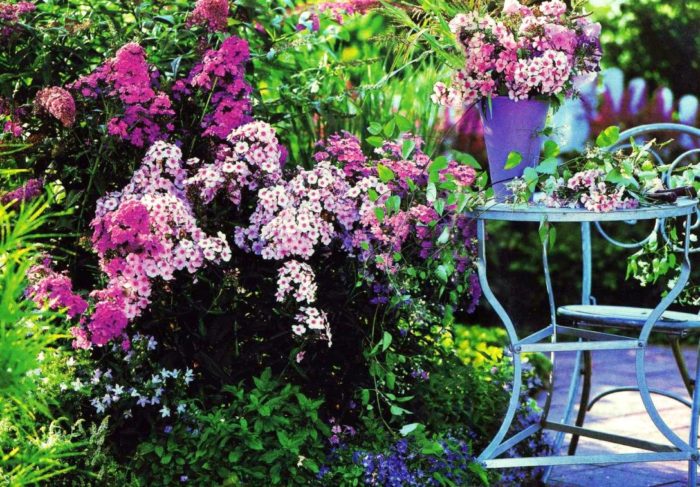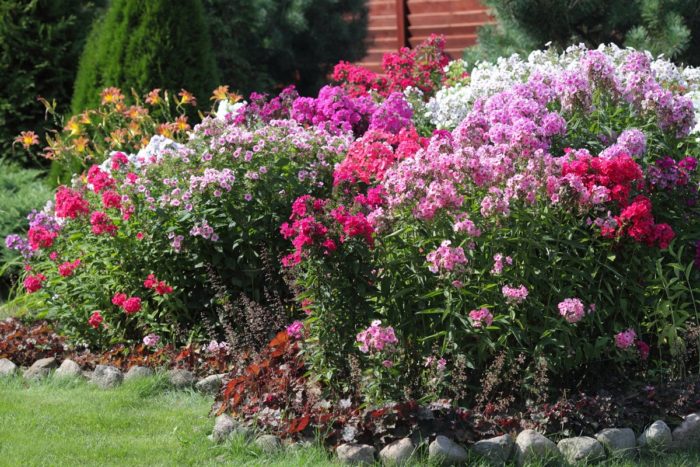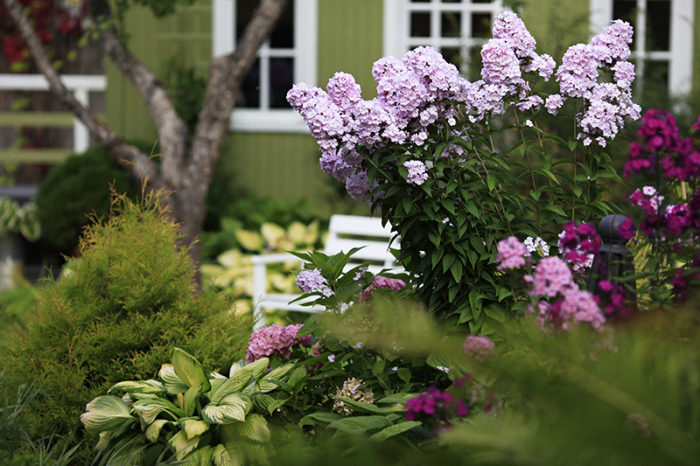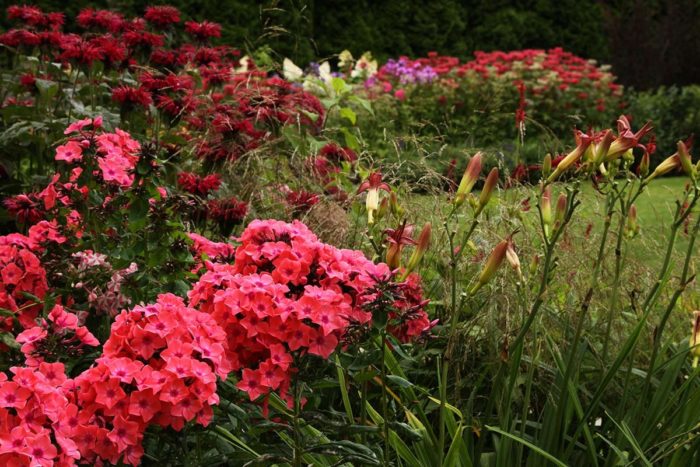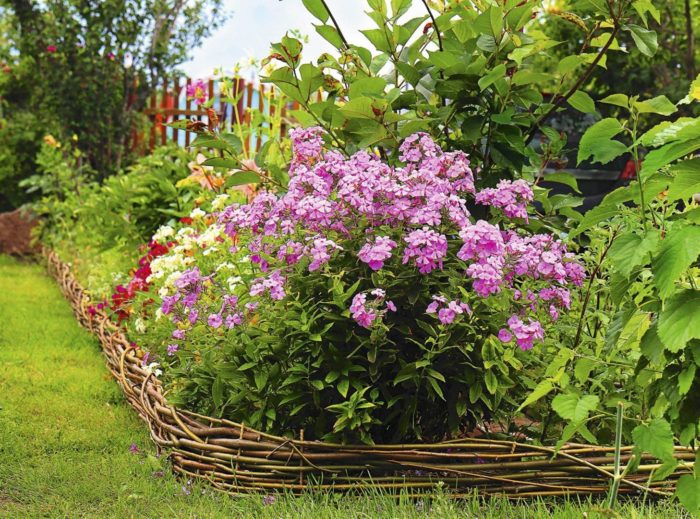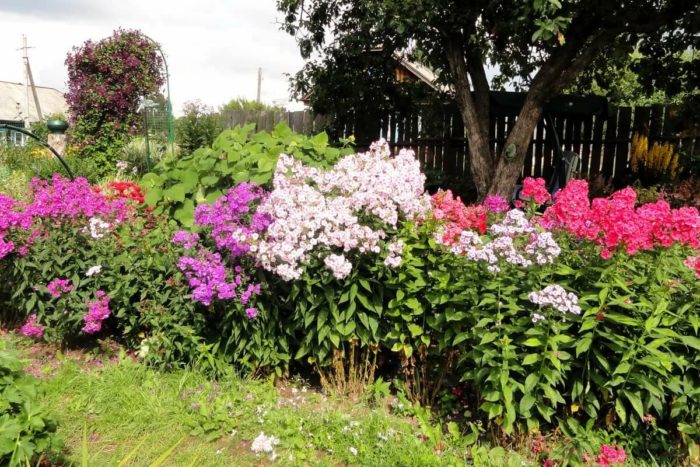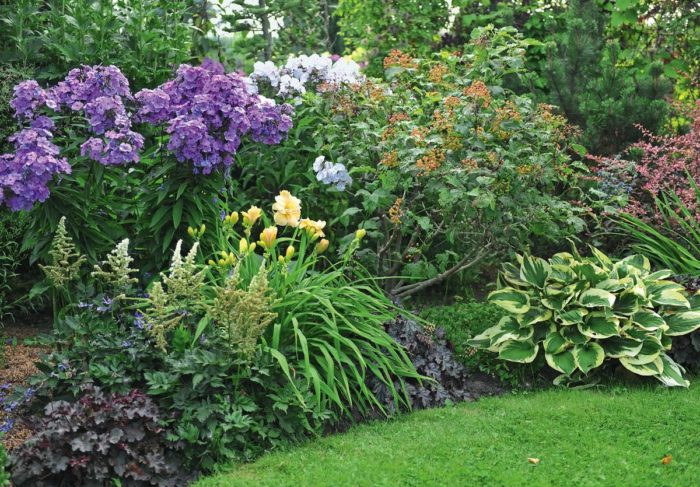Phlox is one of the favorite artistic tools in a garden designer's arsenal. Forty varieties of this flower of different textures and flowering seasons open up a wide field for experimentation. Phlox can be planted with almost anything; in landscape design they coexist with shrubs, flowering and green plants. Unpretentious perennials are universal for decorating flowerpots and outdoor compositions.
- Features of design planning with perennial phlox
- What do phlox go with?
- What flowers can be planted next to phlox?
- Is it possible to plant phlox of different colors side by side?
- Can phlox be planted next to roses?
- Combination of hydrangea and phlox
- Combination of phloxes with other flowers in the flowerbed
- With peonies
- With daylilies
- What ornamental plants are combined with phlox?
- What should you not plant phlox next to in the flowerbed and in the garden?
- Conclusion
Features of design planning with perennial phlox
The name of the flower was given by the natural scientist Carl Linnaeus. Translated from Greek, “phlox” means “flame.” The flowers of the plant are collected in round rosettes and glow brightly against the background of green foliage. There are a total of 85 varieties with creeping, straight and ascending stems ranging in height from 10 to 150 centimeters. Half of them are wild.
When composing compositions, the following classifications will be useful:
| Name | Description |
| Shape and height | Bush with dozens of stems
Intermediate, loose-turf with creeping stems and straight shoots. Creeping, covering the soil with a carpet. |
| Shape of peduncles | paniculata
Splayed subulate |
| Flowering period | Early May
June averages Late, bloom from July to September |
The advantages of phlox include a long period of growth in one place (6-8 years) and continuous flowering with a sequential arrangement of early, middle and late varieties.
What do phlox go with?
When composing a composition, the first thing that is important is a harmonious color combination. It is also necessary to select plants that are grown in the same conditions as phlox. Primary requirements:
- scattered shadow on the site;
- drained soil on a hill without stagnant water;
- abundant watering;
- loamy, slightly acidic or neutral soil.
Low and medium varieties are planted with flowering and green plants, and tall varieties are planted with shrubs. If neighbors bloom earlier or later, the flowerbed will benefit from the play of shades as the seasons change.
What flowers can be planted next to phlox?
There are no special rules for selecting plant varieties and varieties. In this case, the best option will be determined by your own taste. Phlox exude a long-lasting aroma, so they will add a sweet note to the overall bloom of the garden.
A popular combination of bright rosettes is with rosebuds. Rounded inflorescences of “flaming” flowers emphasize the tenderness of hydrangeas. Phlox are also planted in flower beds with daylilies, peonies, and ornamental grasses. Varieties of different colors form a unique combination when flowering at the same time.
The experience of gardeners and designers has allowed us to collect recommendations that will help to correctly plant compositions, taking into account agricultural technology, color and growing conditions.
Is it possible to plant phlox of different colors side by side?
A simple and effective solution is to decorate a multi-colored front garden with “flaming” flowers. When choosing varieties, it is important not to play with the contrast in the height of the stems; the transition from low-growing to tall-growing ones should be smooth. Low-growing varieties are suitable for decorating borders along paths, while flowering paniculate varieties are suitable for borders or group planting.
Tips for decorating a phlox area:
- plant tall varieties in the center, medium ones in the middle, and low ones at the edges;
- take into account the texture of the petals; they can be corrugated, wavy, smooth, with stripes and spots;
- when selecting colors, use the rules of the color wheel;
- combine shades of the same color;
- plant creeping varieties in stripes to create a colorful carpet.
An example of a color combination approved by summer residents: a yellow variety in the center, pink around it, purple in the next circle and white around the edge. The combination of purple, red, pink and white flowers looks great on a green lawn.
Can phlox be planted next to roses?
When composing a composition, it is important to consider that roses will dominate it. Phloxes are given a secondary role as a beneficial shading background. Creeping varieties of herbaceous perennials are suitable for decorating an area with rose bushes. The combination of roses and paniculate phlox is also popular.
Planting Tips:
- tall varieties of roses look good with a border of “flaming” flowers;
- herbaceous varieties that bloom later will decorate faded rose bushes;
- In the design, a game of contrasts and shades of the same tone are acceptable.
A practical example of a color combination: yellow, peach, cream roses and blue, dark blue, lilac phloxes. The classic combination is white with contrasting tones. Terry varieties are especially in harmony with each other.
The danger for a composition of roses and phlox is infection with powdery mildew. Both plants are predisposed to this fungus, so it is better to plant them at intervals and be sure to provide good drainage.
Combination of hydrangea and phlox
The proximity to flowering shrubs is as favorable as that to rose bushes. The accent of the composition will again be larger plants, hydrangeas. Phloxes will set the overall tone. Narrow-leaved, low-growing and creeping varieties are combined with shrubs.
Features of the neighborhood of hydrangeas and phlox:
- medium and tall varieties of “flaming” flowers look harmonious in mixborders with tree-like varieties of flowering shrubs;
- with large lush rosettes of hydrangeas, varieties of herbaceous plants with small flowers look interesting;
- for the spherical white inflorescences of a flowering shrub, a good pair is paniculate herbaceous perennials of red, blue, and purple flowers.
Both plants have lush flowering varieties. An interesting solution is to plant hydrangeas and phlox next to each other in the same color palette and with the same flowering time. An excellent addition to the composition would be a bright green broadleaf hosta planted in the foreground.
Combination of phloxes with other flowers in the flowerbed
Phlox fits harmoniously into compositions with any set of plants. The following recommendations will tell you which neighbors are suitable for varieties with different flowering periods:
- early varieties with subulate peduncles are suitable for decorating borders, rockeries, and alpine hills. Creeping perennials - carnation, aubrieta, cat's paw - go well with them;
- geranium, aster, knotweed and bluebells are suitable for June varieties;
- summer-autumn varieties happily coexist with lungwort, basilisk, astilbe;
- late varieties are combined with spirea.
The flower garden looks rich when “flaming” flowers are adjacent to delphinium, oriental poppy, lupine, primrose, and forget-me-nots. Summer residents especially favor their duet with peonies and daylilies. The plants are perfectly combined in the color scheme of the petals and the timing of flowering.
With peonies
The advantage of peonies is their long flowering period from early spring to late autumn. Thanks to early and late varieties, the garden will be bright throughout the summer season. Peonies are usually planted in the front, center or background of the composition. Even faded plants delight the eye with carved foliage. Against the background of its bright greenery, paniculate varieties of phlox look pleasant.
“Fiery” perennials can be chosen from low-growing and medium-growing varieties, and tall ones will be suitable for tree peonies. In addition, the green leaves of neighbors planted in the forefront have an important function - to hide the stems of phlox, the lower part of which looks unpresentable.
An interesting example of a composition: lilac peonies with pale pink phlox are bordered by forget-me-nots and Turkish carnations. After the peonies have faded, the flowerbed will retain its bright color against the backdrop of their lush greenery.
With daylilies
The combination is often found in garden plots and parks. Large single daylily flowers stand out against the background of inflorescences of small phlox flowers. Both plants have a rich palette of shades, so choosing harmonious tones will be easy.
For the composition, it is better to choose varieties that bloom at the same time - in July-August. A winning combination is low daylilies in the foreground, with tall phloxes behind them. Large white flowers look great from a distance against the bright background of their smaller neighbors in mixborders and multi-level compositions.
A country option is a small flower garden in contrast or in one tone near the veranda or the wall of the house. Phlox and daylilies are compatible in terms of growing conditions. The main thing in choosing a combination is the shade of the petals and the height of the stems.
What ornamental plants are combined with phlox?
Bright flowers look exotic next to shrubs that change the color of leaves and branches, as well as decorative foliage plants. These include:
- Thunberg barberry;
- decorative cabbage;
- fern;
- host;
- small Hoopsie spruce;
- euonymus;
- cotoneaster;
- dwarf wormwood;
- camellia;
- lavender;
- cistus.
Deciduous shrubs in landscape design serve as a plant barrier for other plants against rain and wind. They are also used as zone separators. Bright spots of phlox add a picturesque appearance to hedges.
The “flaming” flowers of creeping varieties form an unusual combination with moss. It also makes an interesting combination with succulents. Stones - granite blocks, limestone, colored pebbles - will add natural color to the composition. Low-growing varieties of “flaming” flowers planted on the sides will decorate stone borders, stairs, and dry streams.
What should you not plant phlox next to in the flowerbed and in the garden?
For flowering perennials, proximity to plants that have a stronger root system is unfavorable. These include:
- tall coniferous trees;
- deciduous fruit trees;
- birch;
- poplar;
- lilac;
- willow.
Large trees are contraindicated for phlox. These perennials can only coexist with dwarf species of woody plants. In this case, plants need to be planted at a distance from each other.
Unfavorable flower neighbors are irises. Their roots also lie close to the surface of the earth. Plants will inevitably enter into a struggle for food.
Phlox and irises have a common fungal disease - rust. An affected flower bed can cause an epidemic in the garden.
Conclusion
Arranging a garden is an exciting and creative endeavor. Among the variety of ornamental plants, phlox stands out for its large selection of varieties, ease of care and bright colors.
Perennials look good against the background of decorative foliage plants and emphasize the beauty of their dominant neighbors. The best companions for them will be roses, peonies, hydrangeas and daylilies, as well as ornamental shrubs.The proximity to fruit trees, large coniferous and deciduous trees is unfavorable, since they have powerful roots and will take away food from the “flaming” flowers.
Phloxes are suitable for decorating small summer cottages and large park areas. They are universal in composing any compositions - alpine slides, mixborders, borders, rockeries.

